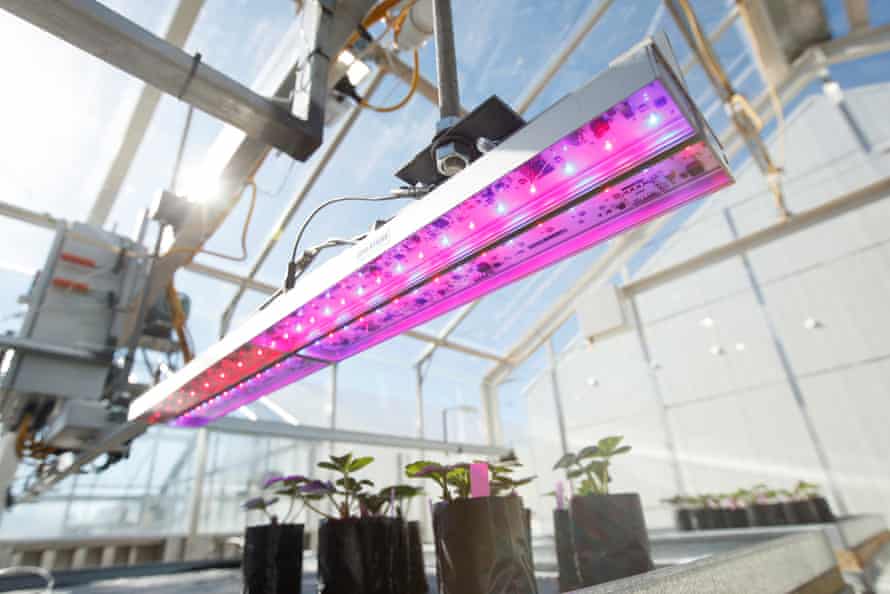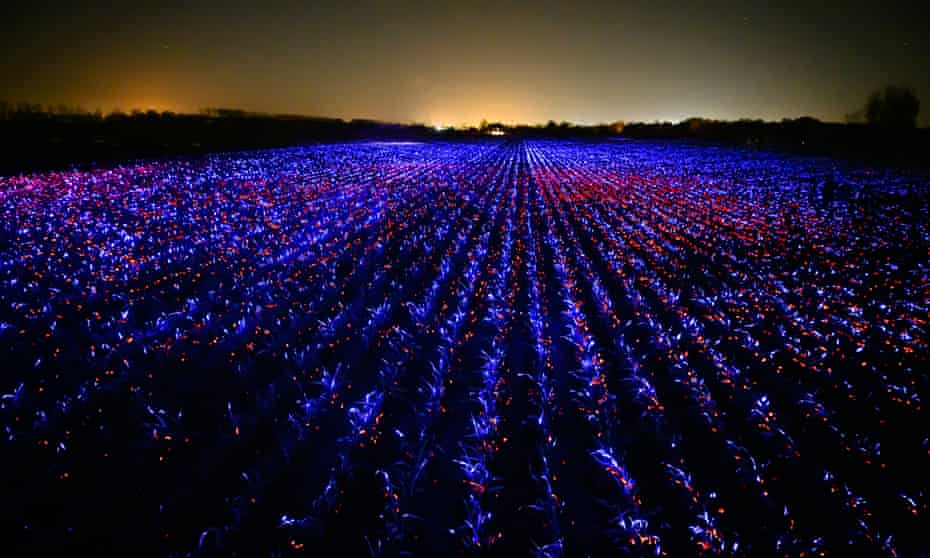By day, the field of leeks looks like any other. But, as the sun sets, blue and red light, mixed with invisible ultraviolet (UV) radiation, transforms the scene into a multicoloured landscape.
This LED light show is not just for effect. For a couple of hours every evening the lights are shone across the 20,000sq metre field in Lelystad in the Netherlands in a bid to make the leeks grow better. In a light installation that brings art and science together, four solar-powered units emit a tailor-made spectrum across the leafy vegetables.
The product of two years’ collaboration between Dutch artist and designer Daan Roosegaarde and plant biologists, Grow showcases a “light recipe” that helps crops grow better by effectively lengthening sunlight hours. “Light is all about communication, and plants are super-sensitive to it,” says Roosegaarde.

For decades, red and blue light has been used in greenhouses and, more recently, in vertical farming operations to improve plant growth and maximise yields. Now it is being applied to crops growing outside.
Prof Jason Wargent is a plant photobiologist working with Roosegaarde to preprogramme the plants using light. “Light acts as an informational cue,” says Wargent, chief science officer and founder of New Zealand-based startup BioLumic. By delivering bespoke combinations of specific types of UV to seeds or seedlings, internal mechanisms can be triggered to increase productivity at a later stage while enhancing the plants’ ability to protect themselves against pests and disease, he explains.

“UV is very specific in terms of the biology that it targets inside the plant, so it triggers things that other lights wouldn’t. It’s a secret, invisible, but potent treatment,” he says.
With an estimated global population of 9 billion to feed by 2050, according to the UN, the pressure to increase agricultural productivity is intense, yet many pesticides and fertilisers can result in pollution once released into the soil and waterways. Wargent suggests that light recipes could be “the next great revolution in agriculture”.
“Farmers need a diverse set of tools now to increase yields. This clean alternative could help reduce the need for agricultural chemicals which themselves are costly and time-consuming to develop, and can pollute the environment once applied,” says Wargent.
“We’re unlocking the plant’s ability to do things, to flower and grow, with a programmable light recipe but without the penalty.”

In the BioLumic lab, UV treatments are applied at the very start of a plant’s journey. They may be applied for seven days for a seedling or just a few minutes for a seed but, once exposed to that burst of radiation, the knock-on effects will last the plant’s lifetime, says Wargent. One step on from Grow, Wargent envisages that an extra stage of light treatment could be integrated into the agricultural processing of seeds before they’re sent to the grower. This year, BioLumic is carrying out extensive field trials of light recipes on US soya bean crops and making light recipes commercially available.
Back in the leek field in Lelystad, the precision lighting design directs beams horizontally across the field. Nothing beams up and the display is localised for just a short time each evening so as not to disrupt wildlife, according to Roosegaarde, who supports the Dark Sky Movement, which aims to reduce light pollution globally.
Roosegaarde hopes that a tour of 40 countries in which he will recreate his artwork – once Covid allows – will push light science to develop even further. “From the rice fields in China to the wheat fields in the US, we can create a light recipe to suit local food production and create an experience that reconnects people with where their food comes from,” he says.

Roosegaarde says he receives hundreds of emails every day from farmers as far flung as Peru and Italy wanting to engage with the project. Light recipes alone won’t solve food security issues but he hopes they will be a welcome addition to the toolbox. He says: “By triggering curiosity for the future, this could speed up the necessary transition.”
The Grow project is just the latest in a series of works by Roosegaarde that tackle environmental problems, including an award-winning smog-filtering tower, a smart highway that charges throughout the day and glows at night, and an art installation that enables visitors to interact with light-emitting algae. His studio is currently working on a project called Urban Sun, which aims to “clean coronavirus in public spaces”.
“There is so much great science and technology but it’s hidden,” says Roosegaarde. “My job is to activate it and shine a light on it.”
Find more age of extinction coverage here, and follow biodiversity reporters Phoebe Weston and Patrick Greenfield on Twitter for all the latest news and features